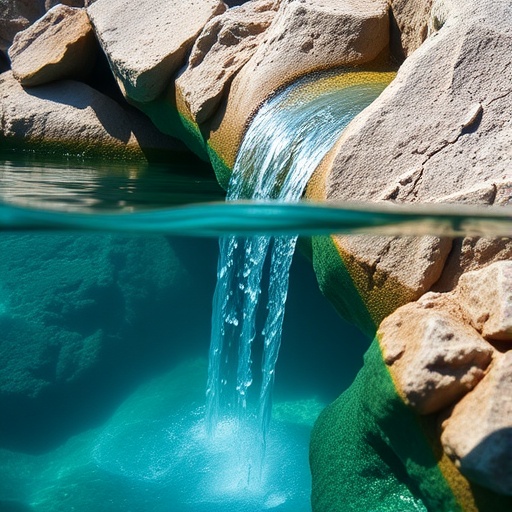In a groundbreaking study published in Nature, researchers unveil the extraordinary electrical behavior of water when confined at the nanoscale, revealing new regimes that challenge conventional understanding of this most ubiquitous liquid. Their work shows that water under confinement does not behave as a homogeneous medium but instead adopts distinct states with remarkable dielectric and conductive properties, fundamentally altering how we conceptualize aqueous interfaces and nanoscale fluidics.
At moderate confinement levels—channels or gaps narrowing down to approximately 2 to 3 nanometers—water can be effectively described as comprising two components: bulk-like water residing at the core, and interfacial water that lines the confining surfaces. This interfacial water exhibits dramatically amplified electrical conductivity—over three orders of magnitude higher in hexagonal boron nitride (hBN) channels—alongside a highly anisotropic dielectric response. Specifically, the dielectric constant perpendicular to the surface hovers near 2, considerably suppressed relative to bulk water, while in-plane values either match or slightly exceed those of the bulk.
This anisotropic dielectric environment corroborates predictions and previous experimental reports, underlining how nanoscale confinement uniquely tunes water’s electrical landscape. Prior theoretical investigations posited that water molecules at interfaces experience orientation and hydrogen-bonding constraints that engender an anisotropic response. The empirical confirmation here affirms these insights and sets the stage for understanding complex water behaviors in confinement across natural and engineered systems.
Remarkably, when the channel height approaches atomic scales that permit only a few molecular layers of water, the system enters a profoundly different regime. This ultrathin quasi-two-dimensional (quasi-2D) water showcases ferroelectric-like polarizability coupled with superionic-like conductivity. Such behavior is unprecedented in bulk water and hints at emergent collective phenomena that transcend simple molecular interactions.
These novel electrical properties align well with molecular dynamics simulations, which have long suggested the formation of highly ordered, layered water structures under extreme confinement. Density oscillations become more pronounced, and predictions of giant, in-plane dielectric constants—akin to ferroelectric materials—are supported by experimental observations. Moreover, the superionic conductivity, ostensibly driven by accelerated proton transport, parallels theoretical models for monolayer water at elevated temperatures, suggesting new routes for ionic conduction in confined environments.
The research also probes the underlying physics governing these anomalies. Atomic confinement imposes severe restrictions on hydrogen-bonding networks, inducing disorder and limiting molecular dipole orientations. This disruption enhances the capacity for water molecules to undergo correlated reorientations, enabling collective polarization phenomena reminiscent of disordered ice phases known for their increased dielectric constants. Such analogies offer a fresh lens through which to interpret water’s exotic electrical characteristics in nanoscale geometries.
Furthermore, the enhanced reorientability of dipoles directly facilitates the Grotthuss mechanism—where protons hop through a hydrogen bond network—thereby promoting rapid proton conduction. This elevated proton mobility accounts for the observed superionic conductivity in the ultrathin water layers, a feature with profound implications for energy devices, bio-inspired transport systems, and nanoscale electrochemistry.
Importantly, the effects documented are expected to manifest broadly across a spectrum of solid-liquid interfaces, not restricted solely to the hexagonal boron nitride substrates used in these experiments. The precise magnitude of dielectric enhancement and conductivity, however, crucially depends on surface chemistry, polarity, and charge density. Variations in these parameters modulate water’s molecular arrangement and dipolar orientation, underscoring the intricate interplay between substrate characteristics and confined water behavior.
Nonetheless, the study acknowledges intrinsic experimental uncertainties—approximately 30%—stemming from the technical challenges inherent in probing electrical properties at such minute scales. Despite this, the core findings remain robust: water’s in-plane dielectric constant and conductivity significantly escalate under confinement, a stark contrast to the suppressed properties measured perpendicular to the interface.
This work fundamentally reshapes our understanding of interfacial water, elucidating how confinement and substrate interactions produce emergent electrical states with potential technological relevance. The implications span fields such as nanofluidics, electrochemistry, energy storage, and biomolecular processes, provoking a reexamination of water’s role in confined environments with unprecedented clarity.
As nanoscale devices and materials continue to shrink, insights into these unique states of water promise to inform innovative designs where controlling ionic pathways and dielectric responses is paramount. The discovery of ferroelectric-like polarizability and superionic conduction in quasi-2D water layers beckons further theoretical exploration and experimental validation, heralding a new era in water science at the molecular frontier.
In sum, this landmark study convincingly demonstrates that the dielectric and conductive properties of water under confinement deviate markedly from bulk behaviors, exhibiting novel, enhanced anisotropic characteristics. By unlocking these regimes, it opens new vistas for manipulating nanoscale aqueous phenomena, with expansive ramifications across science and engineering disciplines.
Subject of Research:
Electrical properties of confined water under nanoscale and atomic-scale confinement.
Article Title:
In-plane dielectric constant and conductivity of confined water.
Article References:
Wang, R., Souilamas, M., Esfandiar, A. et al. In-plane dielectric constant and conductivity of confined water. Nature 646, 606–610 (2025). https://doi.org/10.1038/s41586-025-09558-y
Image Credits:
AI Generated
DOI:
https://doi.org/10.1038/s41586-025-09558-y
Tags: anisotropic dielectric responseaqueous interfaces studybulk vs interfacial waterconfinement effects on waterdielectric properties of confined waterelectrical behavior of liquidselectrical conductivity of waterhexagonal boron nitride channelshydrogen bonding in confined waterinterfacial water phenomenananoscale fluidics researchnanoscale water behavior





